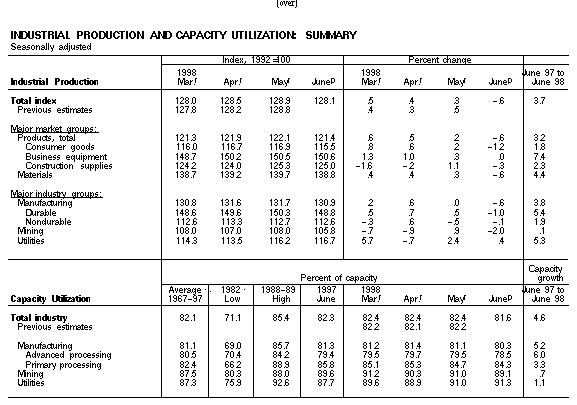

INDUSTRIAL PRODUCTION AND CAPACITY UTILIZATION
Industrial production declined 0.6 percent in June after a revised gain of 0.3 percent in May. Ongoing strikes, which have curtailed the output of motor vehicles and parts, accounted for the decrease in industrial production. Excluding motor vehicles, the output of business equipment posted a strong gain in June; the output of most other major market groups weakened or remained about unchanged. At 128.1 percent of its 1992 average, industrial production in June was 3.7 percent higher than it was in June 1997; excluding the output of motor vehicles and parts, the twelve-month increase was 4.1 percent. Capacity utilization dropped 0.8 percentage point in June, to 81.6 percent.
For the second quarter, industrial output rose 2.5 percent at an annual rate after a gain of 1.2 percent in the first quarter. The improvement in the second quarter was largely attributable to a rebound in utility output as temperatures throughout the country returned to more normal levels. However, manufacturing production decelerated from a 2.3 percent rate of increase in the first quarter to a 1.7 percent rate in the second quarter; manufacturing output excluding motor vehicles also slowed.

Market Groups
The output of consumer goods declined 1.2 percent in June, with the decline in motor vehicles accounting for much of the loss. The production of other consumer durables also fell noticeably and reversed most of the 1.8 percent increase in May. The output of consumer nondurable goods was unchanged in June. The production of nonenergy products has remained sluggish for several months; energy products, a category that was quite volatile earlier in the year, was also little changed last month.
The production of business equipment was unchanged; it was restrained by the drop in assemblies of business vehicles that led to a 5.2 percent decline in the output of transit equipment. Excluding motor vehicles, the production of business equipment advanced sharply in June. Led by a sharp increase in the production of construction machinery, the output of industrial equipment rebounded 2.2 percent after falling in May. The production of other equipment-notably farm machinery and equipment and office furniture and fixtures-also bounced back and more than reversed the decline in May. The output of information processing equipment advanced further, mainly on the strength of gains in the production of computing and office equipment and telephone apparatus.
The output of construction supplies edged down 0.3 percent after having increased 1.1 percent in May and remained close to the high level seen in the first quarter. The production of materials declined 0.6 percent, with weakness both in the durable goods materials used to make motor vehicles and in energy materials. The production of nondurable goods materials was flat, as activity in paper materials declined further and the output of textiles and chemicals continued to be sluggish.
Industry Groups
Manufacturing output declined 0.6 percent, largely owing to the 11 percent drop in production in the motor vehicle and parts industry. Although the strike in the motor vehicle and parts industry contributed significantly to the 1.0 percent drop in production in durable manufacturing, weakness was evident in other industries as well. Output rose in only three industry groups within durables: stone, clay, and glass products; industrial machinery and computing equipment; and electrical machinery. The output of nondurables was little changed, as gains in chemicals and products and in petroleum products were offset by declines in all other industries. Mining activity decreased 2 percent, and output at utilities rose 0.4 percent.
The factory operating rate decreased 0.8 percentage point, to 80.3 percent. The rate for advanced-processing industries fell 1.0 percentage point, to 78.5 percent; the operating rate for motor vehicles and parts fell 8.4 percentage points, a decrease mostly reflecting effects of strikes. The rate for primary-processing industries declined 0.4 percentage point, to 84.3 percent, and has fallen 2 percentage points since the end of last year. The operating rate at mines dropped 1.9 percentage points, to 89.1 percent, while the rate at utilities increased 0.3 percentage point, to 91.3 percent.
This release contains revised estimates of capacity for selected industries for the period March through December 1998.
The revision lowered the estimated growth of aggregate capacity 0.5 percentage point between December 1997 and
December 1998. In addition, the industrial production indexes were revised to reflect the semiannual revision to seasonal
factors for motor vehicle assemblies and for series that use production-worker hours as their monthly indicator.
Seasonal factors were not changed for the period before March 1998.
G.17 Release Tables: